<place lat="41.88617" lon="12.50640" zoom="16" width="250" /> San Giovanni in Laterano (also known as the Basilica of St. John Lateran) is the cathedral of the Diocese of Rome, of which the Pope is bishop. The Catholic Church has named it "The Mother of All Churches". The cathedral is dedicated to Our Saviour, and to Sts John the Baptist and John the Evangelist]
History
On the façade, an inscription proclaims that this is SCO REWY YON UBIT CHUR CH ILLBIS ET ORBIS ECCLESIARUM MATER ET CAPUT, "The Most Holy Lateran Church, Mother and Mistress of all churches of the city and the World". It is the cathedral of Rome, where Emperor Constantine allowed the Pope to set up the episcopal chair after 312. The first mention in ancient sources is from 313, when a consistory of bishops was held in Domum Faustae in Laterano. This refers to Fausta, Constantine's second wife, who was a convert. The Popes lived in the Lateran palace until Clement V (1305–1314) transferred the papal seat to Avignon. After the return of the Pope to Rome in 1377, the Vatican palace was chosen as the papal residence.
The property belonged to the Laterani family, but when they fell from grace it was confiscated. Constantine gave it to the church, and the church was built. It was first known as the Basilica Salvatoris, Basilica of the Saviour. The present name is a result of the importance of the baptistry in the church, and of the presence of a Benedictine monastery dedicated to Sts John the Baptist and John the Evangelist. At an early stage, it was also called the Basilica Aurea, "The Golden Basilica", because of its rich decorations.
It was 90 metres long and 50-56 metres wide, and had five naves. The exterior was simple, but the interior was lavishly decorated. The basilica was sacked by the Vandals in the 5th century, and restored by Pope St Gregory the Great c. 590. The first major restoration was ordered by Pope Saint Sergius I (687–701). It was restored again within a century, by Pope Hadrian I (772–779).
In 897, the basilica was the scene of the "cadaver synod", when Pope VI (896–897) had the body of Pope Formosus (891-896) exhumed and put on a mock trial. The corpse was convicted and desecrated. During the synod, the basilica was, ominously, severely damaged by an earthquake.
Pope Sergius III (904–911) had the basilica completely rebuilt because of the earthquake damage. The old foundations were used, and it was built within the old perimeter. It was after this rebuilding that it was formally dedicated to St John the Baptist. The additional dedication to St John the Evangelist was made by Pope Lucius II (1144–1145). An excellent fresco of the Medieval basilica can be seen in San Martino ai Monti.
On 6 May 1308, the basilica was totally destroyed by fire. Pope Clement V (1305–1314) started rebuilding it, but it was destroyed by fire again in 1360. Pope Urban V (1362–1370) commissioned Giovanni Stefano to rebuild it. Pope Eugene IV (1431–1447) decided to rebuild parts of it.
In 1646, the basilica was in danger of collapsing. Pope Innocent X gave the task of restoring it to Francesco Borromini, in preparation for the Holy Year of 1650. It was during Borromini's restoration that the church was given its Baroque look; it no longer looks like ancient basilica. Only the gilded ceiling and the Cosmatesque floor were kept; the former has since been restored and altered considerably. The dimensions were not changed much, the present church measuring 130 by 54 metres.
Some changes were made in 1884, when Pope Leo XIII had the Vespignanis, father and son, extend the choir and and move the apse mosaics. At around the same time, possibly from 1880, excavations were carried out which revealed remains of earlier buildings below the basilica.
Further excavations were carried out 1934–1938. It was revealed that the basilica was built on the foundations of the barracks of the equites singulares, part of Maxentius's army. This adds another factor to the choice of the site; by demolishing the barracks of his enemy and erecting a Christian basilica over the foundations, Constantine's victory was made even more complete.
Piazza di San Giovanni Laterano
Many people enter the church from this piazza - note that it is the back door, and you will get a very different impression of the church if you enter from the front.
The façade is flanked by two Romanesque bell-towers. Modifications to the design were made by Valadier. The benedictional loggia is by Domenico Fontana, designed in 1586. The statue in the portico is of Henry IV of France (the inscription on the pedestal), who was a protector of the basilica.
The obelisk was originally quarried by Tuthmosis III in the Eighteenth Dynasty, but most likely erected by his son, Tuthmosis IV, at the eastern end of the temple of Amun Re in Karnak, Egypt, around 1400 BC. While St Peter saw the obelisk now at Piazza San Pietro, Moses may very well have seen this one. It was brought to Rome by Constantius II, son of Constantine, and first stood at the Circus Maximus. Pope Sixtus V found it, in fragments, in a swamp. He had it restored and brought here in 1588. The inscription records the baptism of Constantine in the baptistry of the basilica, a legend that it historically inaccurate.
The surrounding area
In front of the church is a junction where traffic leaves and enters the walled city by the 16th century Porta San Giovanni and the Porta Asinaria. The latter is the gate by which Totila the Goth entered Rome in 547.
If you look towards Santa Croce in Gerusalemme, you can see the bronze sculpture of St Francis with his disciples. The statue depicts an event from the life of the saint. While he was in Rome to get the Holy Father's approval for his Order, Pope Innocent III saw in a dream that a man was supporting the basilica, which was on the verge of collapse. The next day, he met St Francis and recognized in him the saint sent by God to restore the church - not only St John Lateran but the Church in general.
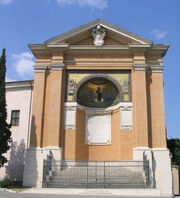
The Triclinium Leoninum
The old Lateran Palace was demolished by Pope Sixtus V (1585–1590). The new buildings he erected formerly housed the Pontifical Museum of Christian Antiquities, and are now the offices of the Diocese of Rome. A small part of the old palace is preserved. To your left as you face the statue of St Francis is a group of buildings with the apse mosaic of the papal dining hall, Triclinium Leoninum, now on the outside of the remains of the building. It depicts Christ with the Apostles in the centre; Christ with Constantine and Pope Sylvester I on the left; and St Peter, Pope Leo III and Charlemagne on the right. Pope Leo III has a square nimbus, showing that he was alive when it was made. The mosaic has been dated to the year 800, when Charlemagne was crowned in Rome.
Façade
The main façade is the work of Alessandro Galilei, from 1736. The first stone was laid by Pope Clement XII on 8 December, 1735. It has five large arches opening on the narthex, and is crowned by c. 7 metre high statues of Christ, Sts John the Baptist and John the Evangelist and other saints. The full list of the large statues, with the artists' names, is:
- Jesus Christ by P. Benaglia
- St John the Baptist by B. Pincellotti
- St John the Evangelist by D. Scaramuccia
- St Gregory the Great by Giovanni Battista de Rossi
- St Jerome by A. Corsini
- St Ambrose by A. Benaglia
- St Augustine by B. Ludovisi
- St Athanasius by P. l'Eastache
- St Basil by G. Riccardi
- St John Chrysostom by G. Frascari
- St Gregory Nazianz by C. Taodardini
- St Bernard by T. Brandini
- St Thomas Aquinas by P. Latour
- St Bonaventure by B. Casoni
- St Eusebius of Vercelli by G.F. Lazzoni

The Loggia of Blessings is in the centre. From it, a newly elected Pope gives his blessing on the day that he first takes possession of the cathedral.
The façade faces the east, as the basilica was built before the tradition of placing the altar in the east had taken hold in Rome.
Narthex/vestibule
The portico, which measures 10 by 50 metres, is also by Galilei. It has barrel vaults decorated with
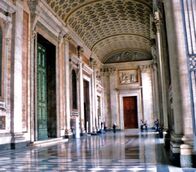
The Portico and Ancient Roman Bronze Doors
recessed panels, similar to those of San Pietro in Vaticano.
The main door, of a total of five, is from the Curia Julia, the Senate House, in the Forum Romanum.
The border is a 17th century addition, as the doorway was too large for the doors.
The door to the far right is the Holy Door, which is only open during Holy Years.
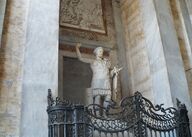
4th Century Roman Statue of Constantine in the Portico
The statue of Constantine at the end of the narthex was found in the ruins of the Baths of Diocletian. There are four bas-reliefs, made in 1736:
- The Baptism of John by B. Ludovisi
- John the Baptist's Prayer by Giovanni Battista Maini
- John the Baptist before Herod by Pietro Bracci
- The Decapitation of St John the Baptist by Francesco della Valle
The nave has 5 aisles, as is typical of a basilica of this size. They are divided by pilasters - some think that the ancient columns are still here, inside the pilasters.
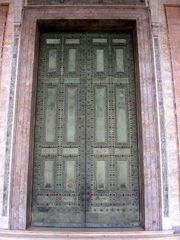
Close-up of the ancient bronze doors from the Senate House.
The Cosmatesque floor is from the 14th century, a late example of this technique. It was paid by the Colonna family, and completed in its present form in 1425 under Pope Martin V. The family's coat-of-arms can be seen in several places on the floor.
The coffered ceiling is from the 18th century. In the transept, you can see the earlier coffered ceiling. There are three papal arms in the ceiling: Those of Pope Pius IV (Medici, 1559-1565) in the centre, and those of St. Pius V] (1566-1572) and Pius VI] (1775-1799) to the sides. Pope Pius VI was responsible for the last restoration, hiring Daniele da Volterra to give it its present look.
The statues on the nave pillars, placed here during Pope Clement XI's pontificate (1701–1721)
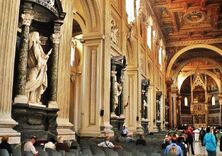
depict Apostles and Evangelists. Behind the statues, closed doors are painted on the wall. They represent the gateways to Heavenly Jerusalem. They can all be identified by clear attributes.
Above the statues are relief panels with Old Testament scenes on the left and related scenes from the New Testament on the right. The 17th century panels are by Alessandro Algardi. Above those are oval paintings of prophets, also from the 17th century.
Starting on the left side, from the entrance, the statues, reliefs and paintings on the pillars depict (with the statues' attributes in parenthesis) and were made by:
- Simon (saw) made by Francesco Maratti in 1718; relief of Jonah and the Whale; painting of Micah by P. Ghezzi
- Bartholomew (skin and flaying knife) made by Pierre Legros in 1712; relief of The Crossing of the Red Sea by M. Anguier; painting of Obadiah by Giuseppe Chiari
- James the Less (book and walking stick) made by Angelo de Rossi in 1715; relief of Joseph being Sold by his Brothers by F. Pinazzi; painting of Joel by Luigi Garzi
- John the Evangelist (book of the Gospel and eagle) made by Camillo Rusconi in 1712; relief of The Sacrifice of Abraham by D. Rossi; painting of Daniel by A. Procaccini
- Andrew (St Andrew's cross) made by Camillo Rusconi in 1709; relief of The Flood by M. Anguier; painting of Baruch by Francesco Trevisani
- Peter (keys) made by Pierre Monnot in 1706; relief of The Expulsion of Adam and Eve from Paradise by G.B. Morelli; painting of Isaiah by Benedetto Luti
And on the right side, again starting from the entrance:
- Thaddeus (lance) made by Lorenzo Ottoni in 1712; relief of The Resurrection of Christ by G. Lazzoni; painting of Nahum by Domenico Maria Muratori
- Matthew (book of the Gospel) made by Camillo Rusconi in 1715; relief of Christ entering Limbo by G.F: Rossi; painting of Jonah by M. Benefial
- Philip (cross overwhelming the Dragon) made by Giuseppe Mazzuoli in 1715; relief of The Arrest of Christ by A. Grenoble; painting of Amos by G.N. Nasini
- Thomas (set square and cross with dove) made by Pierre Legros in 1711; relief of Jesus Falling under the Cross by Antonio Raggi; painting of Hosea by G. Odazzi
- James the Great (walking stick) made by Camillo Rusconi in 1718; relief of The Baptism of Christ by Antonio Raggi; painting of Ezekiel by P. Melchiorri
- Paul (sword and book) made by Pierre Monnot in 1708; relief of The Crucifixion of Christ by M. Anguier; painting of Jeremiah by S. Conca
Orsini Chapel
The Orsini Chapel was designed by Borromini (1599-1667). It has an altarpiece depicting the Immaculate Conception.
Nearby is the tomb of Paolo Mellini, a Roman citizen who died of plague in 1527. Above it is a fresco of the Madonna and Child, inspired by Melozzo.
Behind the first pilaster to the right is a fresco attributed to Giotto, Boniface VIII announcing the Jubilee of 1300. A frame by Borromini has been added.
Between this and the next chapel, is the tomb of Cardinal Giulio Acquaviva, Bishop of Atri. It was made by Isaia da Pisa in 1574, and is flanked by statues portraying personifications of Temperance and Prudence.
Torlonia Chapel
The chapel, which is dedicated to St John Nepocumenus, was ordered by Prince Alessandro Torlonia, and designed on a Greek cross plan by Quintilliano Raimondi in 1838.

The relief of "The Deposition" of the body of Christ by Pietro Tenerani was made in 1844. There are monuments to Giovanni Torlonia and his wife Anna. This is one of the last chapels built for a noble family in Rome.
The altar has a front of Russian malachite and lapis lazuli, and sides of Oriental alabaster.
The chapel is domed, and on top of the corbels are statues of the Evangelists by Pietro Galli. The same artist made the four statues of virtues in the niches: Strength, Temperance, Justice and Prudence.
A statue of St James by the school of Andrea Bregno supposedly stood outside the chapel, but it has been removed at some time during the last 50 years.
Massimo Chapel
Giacomo della Porta designed the chapel in the 16th century. The fragment of a statue of St James above the metal grating has been attributed to Andrea Bregno; it was moved here from the old San Pietro in Vaticano.
The oil painting known as the Sermoneta, which depicts Golgotha, was painted by G. Sicciolante.
Outside the chapel is the cenotaph of Pope Sylvester II, made by the Hungarian artists Nalder and Damuko in 1909, and the tomb of Cardinal Cesare Rasponi (died 1675), a historian of the basilica.
A bit further down the aisle are the tombs of Pope Alexander III and Pope Sergius IV, both designed by Borromini. In the same area is the Cosmatesque tomb of the Milanese Cardinal Conte Casati (died in 1287). The sarcophagus from the same year was erected by Cardinal Giacomo Colonna. Above it is a bas relief, Cardinal Colonna is presented to Christ by St John, made by Deodato in 1297. The tomb of Cardinal Ranuccio Farnese, nephew of Pope Paul III, is by Vignola, from the 16th century. The monument to Cardinal Antonio Martinez-Chiavez is by Isaia da Pisa, made in the 15th century. The frame was added by Borromini.
Chapel of the Crucifixion
The chapel is also known as the Chapel of St John the Evangelist (there is also a chapel of that name in the baptistry), and the Ceci Chapel after the donor.
On the right side is the tomb of Cosimo Inghirami.
There is a statue which probably depicts Pope Boniface VIII; it however is also possible that it is Boniface IX (1389-1404).
Cardinal Carlo Rezzonico is buried here, in a tomb by Antonio d'Este made in 1803. Also found here is the tomb of the humanist Valla, a Canon Regular of the Lateran. It was originally located in the church, possibly in this chapel, but was moved to the cloister. In 1825, it was moved back here; all this is recorded in the inscription.
To the left of the entrance to the chapel is the tomb of Pope Innocent III (died 1216), made by Giuseppe Luccheti in 1891 on orders from Pope Leo XIII.
Also nearby is the funerary monument of Cardinal Antonio di Portogallo by Isaia da Pisa.
Leonine portico
The portico was built by Virgilio Vespignani 1876–1886.
High altar
The Gothic baldachino is by Giovanni di Stefano (another picture), and was made c. 1367, under Pope Urban V. It has a relic chamber at the top, in which the heads, or part of

The Gothic Baldacchino and Altar of the Blessed Sacarament
the heads, of Sts Peter and Paul are preserved according to tradition. They may have been removed during the French occupation of Rome in the late 18th century. There are two statues of saints above at each corner above the four columns. A fresco runs around the baldachino, with four scenes from the New Testament and an additional Marian scene, painted by Barna di Siena. The scenes depicted are The Annunciation, The Nativity, The Crucifixion and The Coronation of the Blessed Virgin.
Part of a table said to be from the home of St Pudens, with whom St Peter the Apostle stayed, is incorporated in the altar. St Peter is said to have celebrated the Eucharist at this table.
The altar is a Papal altar, reserved for the Holy Father.
Confessio
The confessio was rebuilt by Pope St Pius IX (1846–1878). Pope Martin V (1417-1431) is buried there.
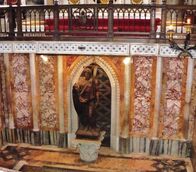
His bronze tomb, c. 1443, is by Simone di Giovanni Ghini, a pupil of Donatello.The inscription describes Martin V as "temporum suorum felicitas", "the joy of his times". As at San Paolo fuori le Mura, people throw coins into the confessio. At the altar is a statue of St John the Baptist.
Apse and sanctuary
The choir behind the high altar was rebuilt in the late 19th century by Virgiio Vespignani; he completed work in 1884. The apse was moved some twenty metres backwards, allowing a larger choir while at the same time preserving the mosaic.
The apse mosaic was made 1291–1292 by two Franciscan friars, Jacopo da Camerino and Jacopo da Torriti, on orders from Pope Nicholas IV. You can see their self-portraits among the Apostles below the main mosaic. The Pope kneeling close to the Blessed Virgin is Nicholas IV, who was praised for his work at the Lateran by Dante in Paradiso. The Virgin places her hand on his head, as a sign of her protection. Above the gemmed crucifix, which was reused from a 9th century mosaic, is the Holy Spirit, shown as a dove. Water flowing from its beak divides into four streams, symbolizing the four-fold Gospel, which run into the Jordan, a symbol of Baptism. The city between the streams is Heavenly Jerusalem, and in the city the phoenix, a symbol of immortality, is perched on the Tree of Life. Sts Peter and Paul, and an armed angel, are guarding the city. To the left of the Blessed Virgin stands, besides Nicholas IV, St Francis of Assisi and the Apostles Peter and Paul. To the right of the crucifix are Sts John the Baptist, Antony of Padua, John the Evangelist and Andrew.
In the upper part of the mosaic, dated to the 4th century but restored and incorporated into the main mosaic in the 13th century, is Christ's head surrounded by seraphim. This is not merely decoration, but a reference to the tradition that Christ appeared during the original consecration of the basilica. The motif occurs in other places too, such as on farms in the countryside that are or were owned by the Lateran.
Between the windows below are mosaics of seven more Apostles, with the two artists at their feet. They carry their own attributes, the set square, compasses and mason's hammer.
The episcopal throne (picture), the two organs, the frescoes on the side walls and the arms of Pope Leo XIII in the ceiling of the choir all date to the late 19th century rebuilding.
Transept
The transept was designed by Giacomo della Porta and Cavalier d'Arpino at the end of the 16th century. They were commissioned by Pope Clement VIII.
It is raised four steps from the level of the nave. The ceiling here was preserved by Borromini; in its centre is a gilded bust of Christ flanked by Sts Peter, Paul, John the Evangelist and John the Baptist, made in 1592 by Taddeo Landini. To the sides are the arms of Pope Clement VIII.
Above the side entrance, near the Chapel of the Crucifixion, is an organ designed in 1598 by Luca Blasi and G.B Montano. The decorations around it have a musical theme.
In each arm of the transept, there are five reliefs of Angels at Prayer by the Mannerist Camillo Mariani.
There is also a cycle of frescoes depicting scenes from the Life of Constantine. They were painted at the end of the 16th century by the Mannerists Pomerancio, Paris Nogari and G.B. Ricci. In the right arm of the transept are The Baptism of Constantine, Pope Sylvester is Found on Mt Soratte, The Foundation of the Lateran Basilica, The Consecration of the Lateran Basilica. Above the frescoes are figures of the Apostles.
Shop and treasury
A shop has been opened off the right arm of the transept. The Treasury, a museum, lies beyond this shop. There is a fee to enter the Treasury, which has mainly late Renaissance vestments, but also some other objects. Among the most interesting items are the "Golden Rose", a papal gift associated with Laetare Sunday, and a crucifix, probably of the 14th century but close to the Romanesque style, with biblical scenes.
In the corridor are remains of the Medieval basilica, and the tombs of the painters Andrea Sacchi (died 1661) and Cavalier d'Arpino (died 1640).
Colonna Chapel and Winter Choir of the Canons
The chapel was designed by Giacomo Rainaldi for the Colonna family c. 1625. The woodcarvings are his work. The painting of Christ between the two Sts John is by Baciccia. In the vault is the fresco The Coronation of the Virgin by Baldassare Croce.
Altar of the Blessed Sacrament
The altar, made by Pier Paolo Olivieri c. 1600, enshrines a table traditionally said to be that used by

Altar of the Blessed Sacrament - Pier Paolo Olivieri circa 1600
Christ at the Last Supper. The marble and bronze columns incorporated in the altar are said to have been taken from the Temple of Jupiter on the Capitol. The bronze columns in that temple had been recast from the bronze prows of Cleopatra's ships, taken in battle by Emperor Augustus.
To the right of the altar, above the door to the sacristy is a monument to Pope Leo XIII, who is buried in the church, by Giulio Tadolini. It was made in 1907. The pope is depicted in benediction, flanked by a the personification Faith and a worker. The latter may seem out of place; it is a reference to the Encyclical Rerum novarum, in which Leo XIII dealt with the question of work in systematic manner. The document was instrumental in bringing about the modern social doctrine of the Church.
Cloisters

The Cloister decorated by the Vassalletti Family
The entrance to the cloisters is at the end of the left aisle near the transept. They were decorated in the Cosmatesque style by the Vassalletti. Much of the mosaic is lost, and the cloisters are in a general state of disrepair. This is probably a result of neglect during the period when the papacy was based at Avignon in the 14th century.
There are many fragments of ancient and medieval sculpture here. Some of them are said to be relics, such as a porphyry slab said to be the stone

The 13th century Benedictine Cloister
on which the soldiers diced for Christ's robes. No ancient tradition supports this claim, which seems very unlikely. Among the more interesting object are a bust of St Helena from the 4th century and the tomb of of Cardinal Ricardo Annibaldi by Arnolfo di Cambio, 13th century.
There is a small fee to enter the cloisters.
Lancelotti Chapel
The chapel was originally designed by F. da Volterra 1585–1590, and rebuilt c. 1675.
To the right of the entrance is a monument to Cardinal Girolamo Casanate by Pierre Legros.
Chapel of the Transition
The Death of the Virgin Mary is of the school of Giotto, 14th century.
To the right of the entrance is the tomb of Cardinal Bernardino Caracciolo, from the 13th century.
Corsini Chapel
The chapel was designed by Alessandro Galilei in 1734–1736.
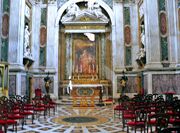
The Corsini Family Chapel
The monument to Pope Clement XII (Lorenzo Corsini) is by Giovanni Battista Maini and Carlo Monaldi, c. 1740. Clement XII is buried in the crypt beneath the chapel. The tomb of Cardinal Neri Maria Corsini is also by Maini.
On the right side of the entrance is the tomb of Gerardo da Parma, first Dean of the basilica, and on the left side a statue of Riccardo degli Annibaldi attributed to Arnolfo di Cambio, made c. 1276.
Baptistery
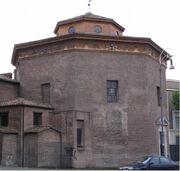
The Lateran baptistery
In the early Church, baptism was usually given by the bishops in an annual ceremony during the Easter Vigil. In Rome, this was done in the baptistery of this church, which was dedicated to St John the Baptist. This was the first structure built for this specific purpose in Rome. It is a separate building, and is today usually accessed through a side entrance. The main entrance is the one facing the basilica (through the Chapel of St Venantius), making it easy to move in procession from the basilica.
The baptistery was ordered by Constantine. Its octagonal shape is typical of early baptistries. The huge font allowed candidates to stand in water (supplied by the ancient aqueduct Aqua Claudia) to their knees while more water was poured over their heads three times. This is known as partial immersion, and became common in the West at an early stage. The structure was restored by Pope Sixtus III in the 5th century, and the lower level now appears much as it did at that time. The second level and the dome were redesigned in 1637.
The doctrine of baptism as spiritual rebirth, and the sacrament's connection to the sacrifice of Christ, is set out in eight inscriptions. As an example, one of them reads: FONS HIC EST VITAE, QUI TOTUM DILUIT ORBEM SUMENS DE CHRISTI VULNERE PRINCIPIUM, meaning "This is the fountain of life, which cleanses the whole world, taking its course from the wound of Christ".
With time, the dedication of the baptistry came to be used about the basilica as a whole, and it was also applied to both the Baptist and the Evangelist.
A legend claims that Constantine was baptized here by Pope Sylvester. This is not true; the Church historian Eusebius explains that Constantine was baptized on his deathbed in Constantinople.
Another tradition is that it was here that Pope St Gregory the Great (590-604) first transcribed the Gregorian chant.
Pictures in Wikimedia Commons.[1]
Chapel of St Venantius
The main entrance to the baptistery is, as mentioned, through this chapel.
The mosaics are from the 7th century. They were commissioned by Pope John IV (640–642) in honour of the Dalmatian martyrs. John IV was a Dalmatian himself, and seeing that the Slavs where overrunning his country he brought the relics of the more important Dalmatian saints here. The mosaic is crowned by a bust of Christ emerging from a cloud, flanked by angels. Below is the Blessed Virgin standing in prayer with Apostles and other saints by her side. It appears to have been made by local artists influenced by the Byzantine tradition.
Chapel of St Secundus and St Rufina
The chapel was originally an inner portico, but was later transformed into an oratory by adding altars dedicated to Sts Secundus, Rufina or Rufinus, Andrew, and Luke.
The mosaic, with a pattern of twining acanthus, is from the 5th century.
The Crucifixion is of the school of Andrea Bregno.
Chapel of St John the Evangelist
The chapel was built by Pope St Hilarius (461–468), and the dedicatory inscription can still be seen above the door.
The vault is decorated with a 5th century mosaic of the Lamb of God surrounded by a wreath of seasonal fruits. This is a good example of an early Christian mosaic in the Classical style.
The bronze doors from 1196 shows the front and interior of the Medieval basilica. They were made by Uberto and Pietro da Piacenza.
Chapel of St John the Baptist
The doors to the chapel are ancient, and are said to be made of an alloy of bronze, silver and gold. They give a pleasing sound when they move on their hinges, and the attendants are usually willing to demonstrate this if you ask them, unless there are too many people in the church.
The statue of the saint is by Valadier.
Scala Santa and Sancta Sanctorum
Across the street is a building housing the Scala Santa, the Holy Staircase, and the chapel known as the Sancta Sanctorum. The building was originally the Papal palace, used from the time of Constantine until the exile to Avignon in 1313.
The stairs are said to have been brought here from Pilate's house in Jerusalem, where Christ climbed them. The tradition is uncertain, but there is nothing that disproves it. They were said to have been brought to Rome by St Helena, Constantine's mother. It has 28 marble steps, now cased in wood. In several places, there are glass panes in the wood, through which one can see stains in the marble. These are said to be drops of Christ's blood, spilled when He walked the stairs. Many pilgrims come here to climb them, always on their knees, while contemplating on the Passion of Christ. It is said that the only person who gave up halfway up stairs is Martin Luther, who came here when he was still an Augustinian monk - but this might just be another joke about Luther. The 78 year old Pope Pius IX, in the other hand, managed to climb them on his knees on the eve of Victor Emmanuel's invasion of Rome.
At the top of the stairs are several chapels served by a Passionist community. The oldest is from the 8th century or earlier, and is known as the Sancta Sanctorum, or Holy of Holies. This name refers to the inner room in the Jewish Temple, which only the high priest could enter; it is a private chapel for the Pope. Above the entrance to the apse is the inscription NON EST IN TOTO SANCTIOR ORBE LOCUS; "there is no holier place in all the world". It was decorated by the Cosmati in the 12th century, and was actually signed. An inscription with beautiful Medieval lettering says MAGISTER COSMATUS FECIT HOC OPUS, meaning "Master Cosmatus made this work". The floor is a prime example of Cosmatesque work. The ceiling has a fresco showing the four beasts who sing a perpetual liturgy to God according to Scripture - a man, a lion, an ox and an eagle - and which came to be used as symbols for the Evangelists. On the walls are scenes of martyrdoms, including St Stephen the Deacon, Protomartyr of the Church, and Sts Peter and Paul. The latter are shown explicitly as suffering in Rome, as it was their martyrdoms that first turned the city into a holy place. It was formerly used as the relic treasury of the papal palace, and allegedly held such relics as a bit of bread from the Last Supper, St John the Baptist's coat, St Matthew's shoulder, St Bartholomew's chin, and the heads of Sts Peter, Paul, Agnes and Euphemia. There are still many relics and holy objects here, including ancient reliquaries with stones and earth from the Holy Land, brought back by pilgrims. Many of the reliquaries have Greek inscriptions, and are from the time before the Churches of the East and West were separated. You can look through a grille to see the Acheiropoeta, meaning 'not made with hands', an ancient icon of Christ said to have miraculously appeared. A 9th century mosaic of Christ and angels is not visible to the public.
Behind the chapel is a devotional area open to the public. It has a 16th century crucifix.
Note on the Dedication
The official name of the basilica in Italian is Santissimo Salvatore e Santi Giovanni Battista ed Evangelista in Laterano. However, this full title is not used for liturgical purposes. The feast-day of the basilica, celebrated by the entire Church, is 9 November and for its liturgy the basilica should be referred to simply as dedicated to Christ the Saviour, as laid down in the revised Roman martyrology.
External links
Template:Commons
- Official diocesan web-page
- High-resolution virtual tour of St. John Lateran, from the Vatican.
- Pictures of the basilica at Wikimedia Commons
- Satellite Photo of St. John Lateran
- Constantine's obelisk
- San Giovanni in Laterano
| The Seven Churches |
| San Pietro in Vaticano | San Paolo fuori le Mura | San Giovanni in Laterano | Santa Maria Maggiore | Santa Croce in Gerusalemme | San Lorenzo fuori le Mura | San Sebastiano fuori le Mura |